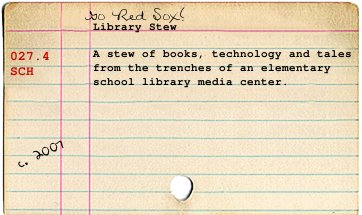I thought back to this summer when we visited author Matt Tavares and his family and we went on a letterbox hunt for some letterboxes that his family had created and hidden on Marginal Way in Ogunquit. Letterboxing is a lot like GeoCaching but without having to use a GPS system - the low tech version. Someone hides a box somewhere, in the box is usually a stamp and an ink pad, a notebook and sometimes a little trinket. You can get the directions to different letterboxes at sites like this one or you can just send out the directions to friends and family who might want to go on a treasure hunt.
My second graders were still having trouble understanding how to find books in our catalog (Destiny Quest) and then writing the call number down and finding the book in the library, I thought this might be a great way to create a "scavenger hunt" to show them in a fun way how to do this.
I had some old plastic video boxes that I should have thrown out awhile ago, but just KNEW I would find something to do with them - these became my letterboxes.
I filled them with a stamp, a stamp pad and a question. I added a spine label to the spine of the boxes and a sticker asking not to remove the boxes (so far only one student has removed one and asked what it was!)When the students find the boxes from the clues I give them they get to stamp the stamp on their paper and in the box there is a question they have to answer (they write the answer on the same paper that they put their stamp on). SInce I have fairly large classes this year I had the class break up into groups of three or four to do this activity.
I created 8 letterboxes and "hid" them in the library. I put the clues on index cards and each group got a clue, when they found the letterbox and answered the question they came back to me for another clue, this way I did not have more than one group looking for the same clue at the same time. Here is an example of one of the clues that the students needed to use to find the letterbox -
CLUE:
1. Go to Destiny on the computer
2. Search for a book on Hank Aaron
3. Write down on scratch paper the call number of the book
4. Find the book in the library using the call number to guide your way. You should find a letterbox near the book. Follow the instruction on your letterbox sheet once you have found the letterbox.
I hid letterboxes in all the key areas of the library (non-fiction, biographies, fiction, everybody, magazines and reference sections.) This lesson followed my lesson on how to use Destiny and a review of call numbers and areas of the library.
I am planning on doing this a few times this year to reienforce the skill so hopefully by the time they leave second grade they will be EXPERTS at finding materials in our library.
Someday when we have devices that can read QR codes, I can see using this same lesson but adding in QR codes in the leterboxes!





2 comments:
Hi there - I love this idea! I have wanted to "spice" up my teaching of Dewey Decimal for a while. No QR codes yet either.
Would you be willing to share your clues with me?
Thanks so much!
Jenny Lussier
jlussier@rsd13.org
What a great idea! I am just beginning to teach the kids how to use Destiny and would love to use your letter box idea. I too am wondering if you would share your clues. Also, do the kids have some sort of paper handed to them ahead of time? How many letterboxes do they find in a session? Thanks!
shelly
shellypickren@gmail.com
Post a Comment